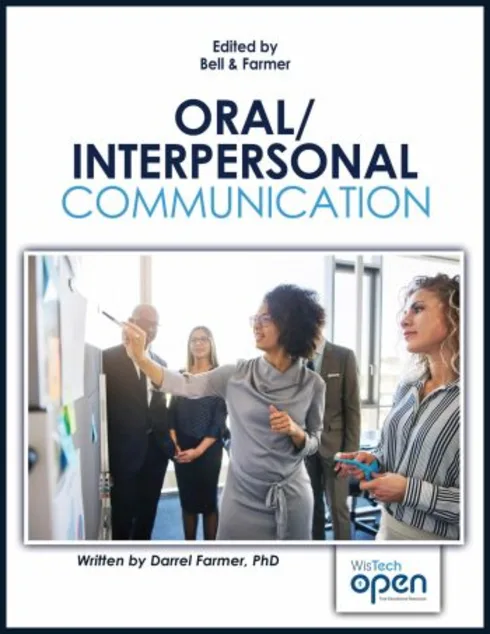
Oral/Interpersonal Communication
![]()
![]()
![]()
![]()
![]()
Darrel Farmer, Chippewa Valley Technical College
Bridget Bell, Gateway Technical College
Copyright Year:
Publisher: WisTech Open
Language: English
Formats Available
Conditions of Use
![]() Attribution
Attribution
CC BY
Reviews
Reviewed by John Drischell, Adjunct Instructor, Oregon State University on 9/12/25
The materials presented covers several core areas typically expected for an introductory or interpersonal-related textbook. The OER examines communication models, nonverbal comm, listening, groups & leadership, conflict management, perception,... read more
![]()
![]()
![]()
![]()
![]()
Reviewed by John Drischell, Adjunct Instructor, Oregon State University on 9/12/25
Comprehensiveness
The materials presented covers several core areas typically expected for an introductory or interpersonal-related textbook. The OER examines communication models, nonverbal comm, listening, groups & leadership, conflict management, perception, self-concept, culture, and speech preparation. Each chapter ends with learning activities, references, and glossary. Additional supplementary materials such as reflection prompts and discussion questions are provided. I would positively rate both the breadth and depth of material included for this textbook.
Content Accuracy
This material aligns well with standard OER frameworks seen previously, while citing mainstream communication texts and recent sources including chapters list references. Definitions align with familiar communication theories (e.g., Shannon-Weaver model, Johari Window). There is solid evidence and backing used throughout, drawing from peer-reviewed sources, established communication textbooks, and recent publications. Concepts are presented objectively without bias toward a specific ideology or cultural viewpoint. Some examples however could use more sources (e.g., especially when citing statistics about technology and attention spans).
Relevance/Longevity
I found many contemporary references (several from 2023–2024) with a good focus on tech & mediated communication (e.g., “Impact of Technology on Communication”). Much of the core content (e.g., nonverbal communication cues) will remain relevant for years. Authors would benefit this OER by occasionally refreshing cultural examples and case studies to reflect evolving norms. There also could be less reliance on naming specific apps and platforms, which could become quickly dated.
Clarity
There are clear learning objectives per chapter, short illustrative scenarios, and concrete language explanations suitable for college-level readers without prior communication study. Figures/captions are also used to support key models. A handful of sentences would benefit from smoother grammar for easier reading, comes off as clunky phrasing here and there.
Consistency
The outline and progression of chapters aligns very well for the sake of consistency. Typically, following Objectives → Sections → Learning Activities → References. Formatting was also consistent across all of the core chapters. The writing voice and tone feels neural and instructional throughout.
Modularity
I would rate this textbook highly modular with numerous sub-sections per chapter making it easy to assign in chunks. Pressbooks also offers multiple download formats for re-ordering or offline use. Cross-chapter self-references are light. Pressbooks platform allows direct linking to specific sub-sections for online courses.
Organization/Structure/Flow
For an interpersonal communication course adoption, this textbook provides a well thought out progression of chapters ranging from foundations (models) to skills (nonverbal, listening), then group/leadership, conflict, intrapersonal (perception, self-concept), culture, and finally speech preparation. This maps well to a one-term course.
Interface
Clean Pressbooks layout with Previous/Next navigation, search, figure labels, and alt-text on images; overview page includes a short “Using the Digital Textbook” video. Multiple download options (PDF/EPUB/Pressbooks XML) are listed. No navigation or display issues encountered.
Grammatical Errors
This OER was mostly polished, but a few fixable hiccups in Chapter 1—for example: “We are always considering the sender’s credibility…” (awkward/tense mix), or “When we minimize noise is essential…” (grammar). I would recommend a light revision pass to correct grammar errors.
Cultural Relevance
There is a full chapter on cultural communication with inclusive scenarios and practical strategies for communicating across cultures. Examples span different national and organizational contexts.
CommentsThis OER is certainly adoptable as-is for an introductory or interpersonal communication course. Strengths are scope, modularity, and organization. To make it outstanding: (1) run a revision for the handful of sentence-level issues and heading capitalization, and (2) consider adding a brief, standalone ethics section (ethics appears in the description but isn’t a dedicated unit).
Table of Contents
- Overview
- Preface
- Acknowledgements
- Introduction
- Chapter 1: Introduction to Communication Situations
- Chapter 2: Nonverbal Communication
- Chapter 3: Listening
- Chapter 4: Leadership and Teamwork Skills
- Chapter 5: Interpersonal Conflict Management
- Chapter 6: Perception
- Chapter 7: Self-Concept
- Chapter 8: Cultural Communication
- Chapter 9: Speech Preparation
- Appendix
- Glossary
About the Book
About the Contributors
Author
Darrel Farmer, Chippewa Valley Technical College
Editor
Bridget Bell, Gateway Technical College
